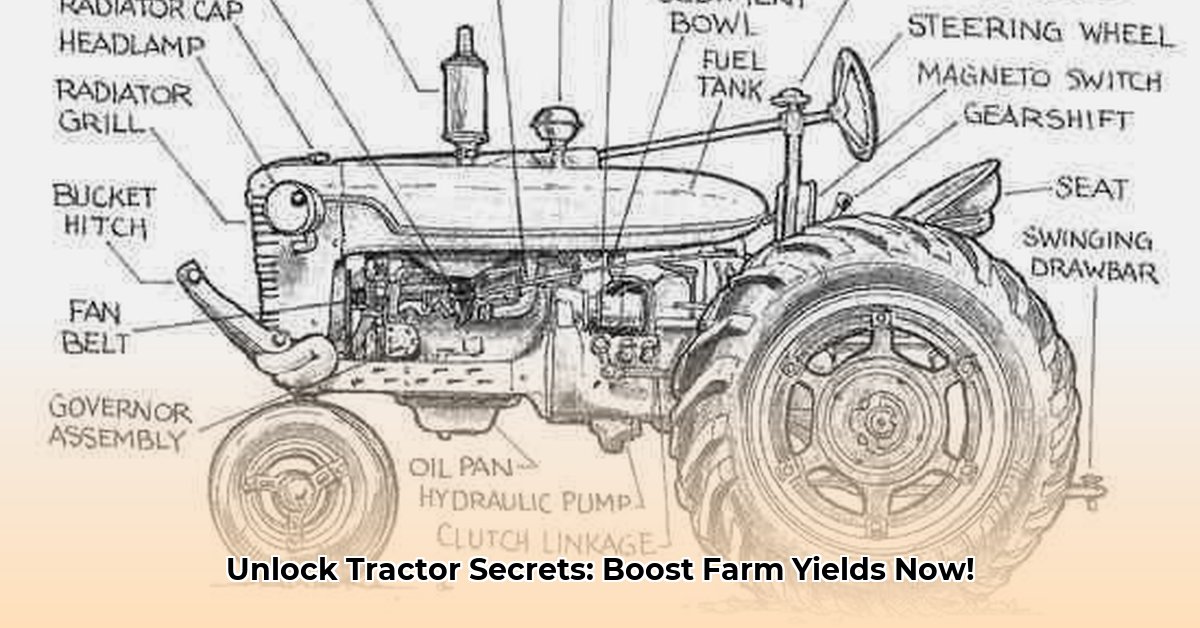
Understanding Tractor Diagrams: Your Visual Guide to Repair
Let's be honest, tractor diagrams aren't always the most exciting thing. But mastering them is key to efficient farm maintenance and repair. Think of them as your tractor's instruction manual – a visual roadmap to keeping your equipment running smoothly. Understanding these diagrams can save you significant time, money, and frustration. Did you know that effective use of diagrams can reduce tractor downtime by up to 30%? For more specific tractor information, check out this helpful resource on Ford 800 tractor specs.
Deciphering the Visual Language of Your Tractor
Tractor diagrams come in various types, each serving a specific purpose. Knowing which type to use is crucial for successful troubleshooting and repair.
Exploded View Diagrams: These diagrams show every part of a component or system disassembled and spread out, like a 3D puzzle. This makes it incredibly easy to identify individual parts and see how they fit together. Imagine assembling IKEA furniture; this is your visual guide to that process for your tractor parts.
Schematic Diagrams: These diagrams provide a high-level overview of how different systems in your tractor interact and function. They show the flow of fluids (fuel, hydraulics, etc.) or electrical signals, like a blueprint of your tractor's inner workings. This is essential for understanding the broader context of a problem.
Wiring Diagrams: These diagrams specifically map out your tractor's electrical system, showing each wire, connector, and component. These are essential for diagnosing electrical faults, just like an electrician's plan for troubleshooting your home electrical system.
Mastering these different diagram types is akin to gaining a superpower in tractor maintenance. They're your problem-solving partners, guiding you through repairs and preventing downtime.
Accessing Tractor Diagrams: Online and Offline Resources
The internet offers a wealth of tractor diagrams, but finding the right resources is crucial. Let's explore some options, highlighting their pros and cons.
Navigating the Digital Landscape: Online Resources
Many websites offer tractor diagrams and manuals, but the quality and accuracy can vary widely. Here's a breakdown of what you can find online:
1. Specialized Parts Websites (e.g., Circle G Tractor Parts): These sites excel at providing detailed exploded view diagrams for individual parts. Finding that specific bolt or gasket is a breeze. However, they often lack comprehensive schematics showing how different systems work together.
2. Comprehensive Online Manuals (e.g., TractorManualz): These sites offer complete service manuals, including detailed diagrams for various tractor models. They're like having a library of information at your fingertips but often come at a cost.
Comparing Online Resources:
| Resource Type | Advantages | Disadvantages |
|---|---|---|
| Specialized Parts Websites | Excellent exploded view diagrams; easy to locate specific parts | Often lack system-level schematics; may be incomplete |
| Comprehensive Online Manuals | Comprehensive manuals; broad model coverage | Often require paid subscriptions; can be complex to use |
Offline Strategies: Tapping Into Traditional Resources
Don't forget the invaluable resources available offline:
Original Manufacturer's Manuals: These comprehensive guides, often available through dealerships, are the gold standard for accuracy and detail.
Local Mechanics: Skilled mechanics possess extensive experience and can often interpret diagrams and offer practical advice, providing context you might miss.
Farmer Networks and Forums: Online and offline communities can be valuable resources, offering tips and troubleshooting advice. However, always verify information from multiple sources.
Practical Applications: Case Studies and Examples
Let's look at real-world examples of how tractor diagrams can be used.
Scenario 1: Hydraulic System Malfunction
Imagine your tractor's hydraulics are sluggish. A schematic diagram will allow you to visualize the hydraulic fluid flow, instantly revealing potential leaks or blockages – saving valuable time and potentially costly repairs.
Scenario 2: PTO Shaft Replacement
Need to replace a worn-out PTO (Power Take-Off) shaft? An exploded view diagram will help you locate the shaft, identify nearby components, and guide you through the removal and replacement process, saving you hours of frustrating guesswork.
Tractor diagrams are not just for major repairs; they're valuable for regular maintenance tasks, simplifying procedures like changing fluids or adjusting belts – preventing small problems from escalating into costly issues.
The Importance of Accessible Tractor Diagrams for Sustainable Agriculture
Access to clear and readily available tractor diagrams directly impacts farm efficiency and sustainability. Reduced downtime means more time spent farming, and lower repair costs improve profitability. This empowers farmers to be more self-sufficient and ultimately increases the long-term viability of their operations. It’s about taking control of your equipment and your agricultural future. Isn't ensuring the smooth operation of your farm essential for sustainable practices?
Key Takeaways:
- Mastering tractor diagrams significantly improves farm efficiency and reduces downtime.
- A combination of online and offline resources provides the most comprehensive approach to accessing necessary information.
- Regular maintenance, aided by readily available diagrams, is crucial for sustainable agricultural practices.